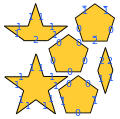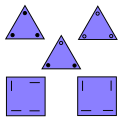List of aperiodic sets of tiles
From Wikipedia, the free encyclopedia
In geometry, a tiling is a partition of the plane (or any other geometric setting) into closed sets (called tiles), without gaps or overlaps (other than the boundaries of the tiles).[1] A tiling is considered periodic if there exist translations in two independent directions which map the tiling onto itself. Such a tiling is composed of a single fundamental unit or primitive cell which repeats endlessly and regularly in two independent directions.[2] An example of such a tiling is shown in the adjacent diagram (see the image description for more information). A tiling that cannot be constructed from a single primitive cell is called nonperiodic. If a given set of tiles allows only nonperiodic tilings, then this set of tiles is called aperiodic.[3] The tilings obtained from an aperiodic set of tiles are often called aperiodic tilings, though strictly speaking it is the tiles themselves that are aperiodic. (The tiling itself is said to be "nonperiodic".)

Click "show" for description.
A periodic tiling with a fundamental unit (triangle) and a primitive cell (hexagon) highlighted. A tiling of the entire plane can be generated by fitting copies of these triangular patches together. In order to do this, the basic triangle needs to be rotated 180 degrees in order to fit it edge-to-edge to a neighboring triangle. Thus a triangular tiling of fundamental units will be generated that is mutually locally derivable from the tiling by the colored tiles. The other figure drawn onto the tiling, the white hexagon, represents a primitive cell of the tiling. Copies of the corresponding patch of coloured tiles can be translated to form an infinite tiling of the plane. It is not necessary to rotate this patch in order to achieve this.
The first table explains the abbreviations used in the second table. The second table contains all known aperiodic sets of tiles and gives some additional basic information about each set. This list of tiles is still incomplete.
Explanations
| Abbreviation | Meaning | Explanation |
|---|---|---|
| E2 | Euclidean plane | normal flat plane |
| H2 | hyperbolic plane | plane, where the parallel postulate does not hold |
| E3 | Euclidean 3 space | space defined by three perpendicular coordinate axes |
| MLD | Mutually locally derivable | two tilings are said to be mutually locally derivable from each other, if one tiling can be obtained from the other by a simple local rule (such as deleting or inserting an edge) |
List
| Image | Name | Number of tiles | Space | Publication Date | Refs. | Comments |
|---|---|---|---|---|---|---|
 | Trilobite and cross tiles | 2 | E2 | 1999 | [4] | Tilings MLD from the chair tilings. |
 | Penrose P1 tiles | 6 | E2 | 1974[5] | [6] | Tilings MLD from the tilings by P2 and P3, Robinson triangles, and "Starfish, ivy leaf, hex". |
 | Penrose P2 tiles | 2 | E2 | 1977[7] | [8] | Tilings MLD from the tilings by P1 and P3, Robinson triangles, and "Starfish, ivy leaf, hex". |
 | Penrose P3 tiles | 2 | E2 | 1978[9] | [10] | Tilings MLD from the tilings by P1 and P2, Robinson triangles, and "Starfish, ivy leaf, hex". |
 | Binary tiles | 2 | E2 | 1988 | [11][12] | Although similar in shape to the P3 tiles, the tilings are not MLD from each other. Developed in an attempt to model the atomic arrangement in binary alloys. |
 | Robinson tiles | 6 | E2 | 1971[13] | [14] | Tiles enforce aperiodicity by forming an infinite hierarchy of square lattices. |
 | Ammann A1 tiles | 6 | E2 | 1977[15] | [16] | Tiles enforce aperiodicity by forming an infinite hierarchal binary tree. |
 | Ammann A2 tiles | 2 | E2 | 1986[17] | [18] | |
 | Ammann A3 tiles | 3 | E2 | 1986[17] | [18] | |
 | Ammann A4 tiles | 2 | E2 | 1986[17] | [18][19] | Tilings MLD with Ammann A5. |
 | Ammann A5 tiles | 2 | E2 | 1982[20] | [21][22] | Tilings MLD with Ammann A4. |
| No image | Penrose hexagon-triangle tiles | 3 | E2 | 1997[23] | [23][24] | Uses mirror images of tiles for tiling. |
| No image | Pegasus tiles | 2 | E2 | 2016[25] | [25][26] | Variant of the Penrose hexagon-triangle tiles. Discovered in 2003 or earlier. |
 | Golden triangle tiles | 10 | E2 | 2001[27] | [28] | Date is for discovery of matching rules. Dual to Ammann A2. |
 | Socolar tiles | 3 | E2 | 1989[29] | [30][31] | Tilings MLD from the tilings by the Shield tiles. |
 | Shield tiles | 4 | E2 | 1988[32] | [33][34] | Tilings MLD from the tilings by the Socolar tiles. |
 | Square triangle tiles | 5 | E2 | 1986[35] | [36] | |
 | Starfish, ivy leaf and hex tiles | 3 | E2 | [37][38][39] | Tiling is MLD to Penrose P1, P2, P3, and Robinson triangles. | |
 | Robinson triangle | 4 | E2 | [17] | Tiling is MLD to Penrose P1, P2, P3, and "Starfish, ivy leaf, hex". | |
 | Danzer triangles | 6 | E2 | 1996[40] | [41] | |
 | Pinwheel tiles | E2 | 1994[42][43] | [44][45] | Date is for publication of matching rules. | |
 | Socolar–Taylor tile | 1 | E2 | 2010 | [46][47] | Not a connected set. Aperiodic hierarchical tiling. |
| No image | Wang tiles | 20426 | E2 | 1966 | [48] | |
| No image | Wang tiles | 104 | E2 | 2008 | [49] | |
| No image | Wang tiles | 52 | E2 | 1971[13] | [50] | Tiles enforce aperiodicity by forming an infinite hierarchy of square lattices. |
 | Wang tiles | 32 | E2 | 1986 | [51] | Locally derivable from the Penrose tiles. |
| No image | Wang tiles | 24 | E2 | 1986 | [51] | Locally derivable from the A2 tiling. |
 | Wang tiles | 16 | E2 | 1986 | [17][52] | Derived from tiling A2 and its Ammann bars. |
 | Wang tiles | 14 | E2 | 1996 | [53][54] | |
 | Wang tiles | 13 | E2 | 1996 | [55][56] | |
 | Wang tiles | 11 | E2 | 2015 | [57] | Smallest aperiodic set of Wang tiles. |
| No image | Decagonal Sponge tile | 1 | E2 | 2002 | [58][59] | Porous tile consisting of non-overlapping point sets. |
| No image | Goodman-Strauss strongly aperiodic tiles | 85 | H2 | 2005 | [60] | |
| No image | Goodman-Strauss strongly aperiodic tiles | 26 | H2 | 2005 | [61] | |
 | Böröczky hyperbolic tile | 1 | Hn | 1974[62][63] | [61][64] | Only weakly aperiodic. |
| No image | Schmitt tile | 1 | E3 | 1988 | [65] | Screw-periodic. |
 | Schmitt–Conway–Danzer tile | 1 | E3 | 1988 | [65] | Screw-periodic and convex. |
 | Socolar–Taylor tile | 1 | E3 | 2010 | [46][47] | Periodic in third dimension. |
| No image | Penrose rhombohedra | 2 | E3 | 1981[66] | [67][68][69][70][71][72][73] | |
 | Mackay–Amman rhombohedra | 4 | E3 | 1981 | [37] | Icosahedral symmetry. These are decorated Penrose rhombohedra with a matching rule that force aperiodicity. |
| No image | Wang cubes | 21 | E3 | 1996 | [74] | |
| No image | Wang cubes | 18 | E3 | 1999 | [75] | |
| No image | Danzer tetrahedra | 4 | E3 | 1989[76] | [77] | |
 | I and L tiles | 2 | En for all n ≥ 3 | 1999 | [78] | |
 | Aperiodic monotile using dendrites (Mampusti/Whittaker) | 1 | E2 | 2021 | [79] | Monotile using dendrites and a seed tile |
 | Aperiodic spiral monotile (Klaassen) | 1 | E2 | 2022 | [80] | Monotile (one matching rule) using a seed tile |
 | Smith–Myers–Kaplan–Goodman-Strauss or "Hat" polytile | 1 | E2 | 2023 | [81] | Mirrored monotiles, the first example of an "einstein". |
 | Smith–Myers–Kaplan–Goodman-Strauss or "Spectre" polytile | 1 | E2 | 2023 | [82] | "Strictly chiral" aperiodic monotile, the first example of a real "einstein". |
 |
TS1 | 2 | E2 | 2014 | [83] | Supertile made of 2 tiles |
References
External links
Wikiwand - on
Seamless Wikipedia browsing. On steroids.
